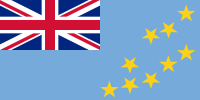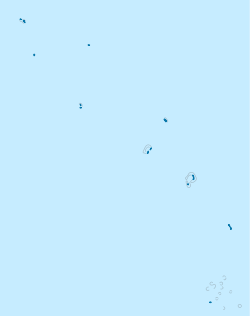- Nui (atoll)
-
Nui — Atoll — Aerial view of Nui Location in Tuvalu Coordinates: 07°13′29″S 177°09′37″E / 7.22472°S 177.16028°ECoordinates: 07°13′29″S 177°09′37″E / 7.22472°S 177.16028°E Country Tuvalu Area - Total 3.37 km2 (1.3 sq mi) Population (2002) - Total 548 - Density 162.6/km2 (421.2/sq mi) Demonym Nuian Nui is an atoll and one of nine districts of the Pacific Ocean state of Tuvalu. It has a land area of 3.37 km² and a population of 548 (2002 census).
Contents
Geography
Nui consists of at least 21 islets. These are:
- Fenua Tapu
- Motupuakaka
- Pakantou
- Piliaieve
- Pongalei
- Talalolae
- Telikiai, also known as Meang
- Tokinivae
- Unimai
- and at least 12 other islands
The biggest, most southern and most eastern island is Fenua Tapu (area 1.38 km² [1]), which is followed by Telikiai (which is the most western islet), Tokinivae, Pongalei, Talalolae, Pakantou, Unimai, Piliaieve and Motupuakaka. Most human habitation in Nui is on the western end of Fenua Tapu where a village including the settlements of Fenua Tapu and Tanrake lies. The junior school is Vaipuna Primary School.
Languages and history
The people of Nui speak the Gilbertese language, the language of Kiribati, and Tuvaluan, the official language of Tuvalu. The ancestors of Nui came from the Gilbert Islands in what is now Kiribati. The island was sighted in January 1568 by Spanish navigator Álvaro de Mendaña y Neyra, who named it Isla de Jesús (Spanish for "Island of Jesus") but was unable to land.[2][3][4]
The population of Nui from 1860-1900 is estimated to be between 250[5] and 300 people.[6]
Notable natives
A notable local person is Iakoba Italeli, Governor-General of Tuvalu since 16 april 2010 and former Minister of Education, Sports and Health, representing Nui in the Parliament.
References
- ^ http://www.botany.hawaii.edu/faculty/duffy/arb/282-292/283.pdf
- ^ Maude, Islands and Men: Studies in Pacific History, Melbourne: Oxford University Press (1986)
- ^ Keith S. Chambers & Doug Munro, The Mystery of Gran Cocal: European Discovery and Mis-Discovery in Tuvalu, 89(2) (1980) The Journal of the Polynesian Society, 167-198
- ^ Laumua Kofe, Palagi and Pastors, Tuvalu: A History, Ch. 15, (U.S.P./Tuvalu)
- ^ W.F. Newton, The Early Population of the Ellice Islands, 76(2) (1967) The Journal of the Polynesian Society, 197-204.
- ^ Richard Bedford, Barrie Macdonald & Doug Monro, Population Estimates for Kiribati and Tuvalu (1980) 89(1) J. of the Polynesian Society 199
External links
- Map of Nui
- "A Brief History of Tuvalu" containing discussion of history of Nui
Islands and atolls of Tuvalu Islands 
Atolls Islets of Funafuti Amatuku • Avalau • Falaoigo • Fale Fatu • Fatato • Fongafale • Fuafatu • Fuagea • Fualefeke • Fualopa • Funafala • Funamanu • Luamotu • Mateika • Motugie • Motuloa • Mulitefala Nukusavalevale • Papa Elise • Pukasavilivili • Te Afuafou • Te Afualiku • Tefala • Telele • Tengasu • Tepuka • Tepuka Vili Vili • Tutanga • VasafuaIslets of Nanumea Islets of Nui Fenua Tapu • Telikiai aka Meang • Motupuakaka • Pakantou • Piliaieve • Pongalei • Talalolae • Tokinivae • UnimaiIslets of Nukufetau Faiava Lasi • Fale • Funaota • Kongo Loto Lafanga • Lafanga • Matanukulaelae • Motufetau • Motulalo • Motuloa (north of Nukufetau) • Motuloa (south of Nukufetau) • Motumua • Niualuka • Niuatui • Oua • Sakalua • Savave • Teafatule • Teafuaniua • Teafuanonu • Teafuone • TemotulotoIslets of Vaitupu Categories:- Atolls of Tuvalu
- Nui (atoll)
Wikimedia Foundation. 2010.


